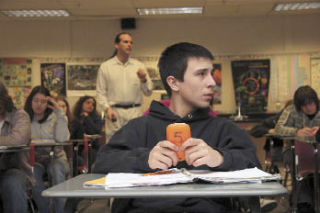For some students, a biology lesson is a far cry from the highlight of their day. Most of the 26 students in teacher Andrew Rapin’s Mount Si High School class seem more concerned with their social calendars than the intricacies of understanding genetic inheritance.
Trying to make their classmates laugh, a handful of students tried hijacking a class discussion last week on probability and genetics.
“Genetics and probability go together like peanut butter and jelly,” Rapin told the students.
“I don’t like peanut butter and jelly,” one girl said.
“What? You’re missing out,” a boy said to her.
Rapin wrestled the class’ focus back to genetics thanks, in part, to an orange and black handheld device.
The devices — known as ACTIV Expressions, or ‘clickers’ — make use of students’ familiarity with texting. Teachers ask the class questions, and the students respond using the clickers. Answers can be simple multiple choice or short texts of up to 100 characters.
Rapin asked the class what the offspring would look like if someone cross-bred a tall plant and a short plant. As students clicked in their answer, the results appeared immediately on the overhead display. Seventy-five percent of the class answered ‘D’ — half of the offspring would be tall and half would be short. A few answered ‘C’ — all the offspring would be medium size. One student answered ‘A’ — all the offspring would be tall.
The answer: A.
Having identified that the students’ assumptions about genetics were wrong, Rapin explained to them how genetic inheritance works, how recessive genes are hidden by dominant genes in the first generation but reemerge in subsequent generations.
At the end of the class, he asked a similar question. This time, all the students answered correctly.
Rapin has been using the clickers for two years, thanks to grants from the Snoqualmie Valley Schools Foundation. They help uncover students’ preconceptions about a particular topic, which is helpful when teaching biology.
“In science, it’s not what they know, but what they think they know,” he said.
Student participation has increased because of the clickers, which Rapin has students use during lectures and while doing lab work.
“Sometimes with larger class sizes, its harder to engage all the students,” he said.
Students use the clickers to share their observations while doing lab work.
“A lot of students are afraid to share their explanation with their peers,” but the clickers, which allow anonymous responses, remove that fear, Rapin said.
Teachers are able to track each student’s responses over the year, and can address any negative trends they see. Rapin uses the clickers to evaluate himself, as well. Students use them to complete a questionnaire about their understanding of subjects at the beginning and end of a section. Rapin compares the results to evaluate his teaching and their learning level.
The clickers were purchased by the Snoqualmie Valley Schools Foundation as part of a district-wide initiative. The foundation has spent $50,000 on related ACTIV technology in the high school over the past two years, and plans to spend $58,000 on new systems for the high school and all three middle school.
Mount Si’s math and science departments have used ACTIV technology the most so far, but Rapin said he hopes other departments will begin integrating it into their curriculum.
“We found that in times of budget cuts and increasing class size, having this tool in the classroom helps teachers use their time more efficiently,” said Carolyn Simpson, the foundation’s president.
The clickers are part of the foundation’s plan to donate $165,000 across the district over the next two years.
“With the economy, it may take us a little longer” to raise the money, Simpson said.
As part of the spending campaign, the foundation plans to buy $51,000 worth of laptops and monitoring equipment for Mount Si ‘s science department.
The high school is piloting a program using mini-laptops for lab work. The rugged computers can be used outside and can take over 150 attachments to use in experiments.
The laptops will allow students to more accurately record results and share them with ease, Rapin said.
For example, a student will be able to take a photo of what he sees under his microscope and share it with the class.
The laptops have been ordered, and should be in use by early April, Rapin said.


